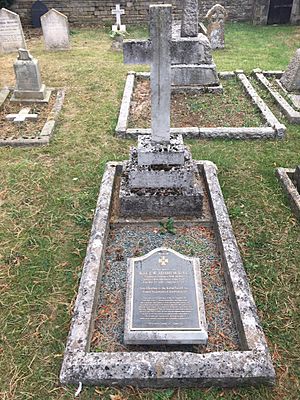James Adams (chaplain) facts for kids
Quick facts for kids
James Williams Adams
|
|
|---|---|

Reverend James Adams on a cigarette card
|
|
| Born | 24 November 1839 Cork, Ireland |
| Died | 20 October 1903 (aged 63) Ashwell, Rutland |
| Buried |
Churchyard of St Mary's Church, Ashwell, Rutland
|
| Allegiance | United Kingdom |
| Service/ |
Bengal Ecclesiastical Department |
| Battles/wars | Second Anglo-Afghan War Third Anglo-Burmese War |
| Awards | Victoria Cross Mentioned in Despatches (3) |
| Other work | Honorary Chaplain to King Edward VII |
James Williams Adams (24 November 1839 – 20 October 1903) was an Irish Anglican chaplain. He received the Victoria Cross (VC), which is the highest award for bravery given to British and Commonwealth forces. He was the first clergyman (a religious leader) to earn the VC. He was also the last of five civilians to receive this special award.
Contents
Who Was James Adams?
Early Life and Education
James Williams Adams was born in Cork, Ireland. His birthday was November 24, 1839. He was the only son of James O'Brien Adams, who was a magistrate, and his wife, Elizabeth Williams.
He went to school at Hamblin and Porter's Grammar School in Cork. Later, he studied at Trinity College, Dublin. He became a priest in 1863. His first jobs as a priest were in Hyde, Hampshire (1863-1865) and Shottesbrooke, Berkshire (1865-1866). In October 1866, Adams became a chaplain in Bengal, India. He worked under Bishop Robert Milman in Calcutta.
His Victoria Cross Award
Reverend James Williams Adams was 40 years old when he earned the Victoria Cross. He was a chaplain in the Bengal Ecclesiastical Department. This meant he served as a chaplain to the Kabul Field Force during the Second Anglo-Afghan War.
On December 11, 1879, he performed a very brave act. This act led to him receiving the VC. The story of his bravery was officially published on August 24, 1881.
Here is what happened: During a battle at Killa Kazi, some soldiers from the 9th Queen's Royal Lancers fell into a wide, deep ditch called a "nullah". Their horses fell on top of them. The enemy was very close by. Reverend Adams quickly jumped into the water, which filled the ditch. He was up to his waist in water. He pulled the horses off the trapped soldiers. He helped the soldiers get out of the ditch. All this time, he was under heavy enemy fire.
The Afghan soldiers were coming very fast. The first enemy soldiers were only a few yards from Mr. Adams. He had let go of his own horse to help the men more effectively. Because of this, he had to escape on foot.
Lord Roberts recommended Adams for the Victoria Cross. Adams was also mentioned three times for his bravery during the war. This was along with other chaplains who were with the force. Queen Victoria herself gave him his medal. This happened at Buckingham Palace on December 1, 1881.
Later Life and Work
In 1885, James Adams went with Lord Roberts' forces to Burma. He took part in the military operations there during the Third Anglo-Burmese War.
After returning to England, he continued his work as a clergyman. He was the rector of Postwick from 1887 to 1894. Then he was the vicar of Stow Bardolph from 1895 to 1902. Both of these places are in Norfolk. In 1902, he became the rector of Ashwell, Rutland.
Adams was also given an important role with the Royal Family. He became an honorary chaplain to the Prince of Wales on May 7, 1900. When the Prince became King Edward VII, Adams was confirmed as an honorary chaplain to the King. This happened on July 23, 1901. Later, he was appointed as one of twelve chaplains-in-ordinary to the King.
James Adams passed away on October 20, 1903. He was buried four days later. His grave is in the churchyard of St Mary's Church, Ashwell, Rutland. He was the rector there when he died. His grave was repaired in 2007.
On August 16, 1881, he married Alice Mary. She was the oldest daughter of Sir Thomas Willshire, 1st Baronet. They had one daughter named Edith. Edith later married Geoffry Northcote.
See also
- Siege of the Sherpur Cantonment
Images for kids



